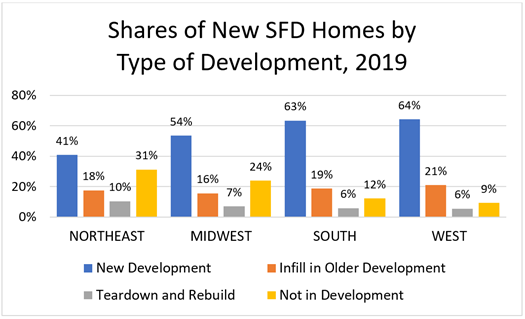Ed Hudson, MBA
November 13, 2020
Home, Home on the … Infill Lot
Builder Practices Report Shows Where SFD Homes are Being Built
While the markets for new homes and building materials roil with unpredictability, there are some things in the new home construction industry that are a little more stable—such as the types of building lots available. “They’re not making any more land,” the old adage goes, and land for new residential developments is universally reported to be in extremely short supply.
In early 2020, Home Innovation’s Builder Practices Survey expanded its questionnaire to include the types of development where builders constructed single-family detached homes. More than 1,400 builders completed this question. Our Infrastructure Report reveals that new single-family homes are least likely to be built in a new residential development in the most densely populated regions of the country; reflecting the dwindling supply of new residential development land in these parts of the country.

Source: 2020 Annual Builder Practices Report, Home Innovation Research Labs
In the South and West, which have much higher numbers of single-family housing starts, homes built in new developments represented nearly 2/3 of the total. Slightly more than half the new homes built in the Midwest, and about 40% of homes built in the Northeast, were in new developments.
Conversely, the percent of homes built on land “Not in Development”—typically on rural parcels—was highest in the Northeast and Midwest. Not much regional difference was seen in the share of homes built on Infill Lots in Older Neighborhoods.
Teardowns were highest in the Northeast, where housing stock is older than in other regions, followed by the Midwest. According to the updated Annual Builder Practices Report, about 48,000 new homes are projected to be Teardown/Rebuilds in the United States in 2020.
The highly-anticipated 2021 Builder and Consumer Practices Surveys are now in the field, and the findings will be reported in early 2021. These reports will provide precision to our understanding of how home construction materials choices and home remodeling activities have changed during the first year of the pandemic. In the meantime, we updated our 2020 Builder Practices Reports in November with a much more optimistic housing forecast for 2020 and beyond, reflecting a higher building materials volume as a result of the unexpectedly strong housing market. Below is a summary of our Builder and Consumer Practices Report titles (not all product categories are available in both report series):
Air Sealing | Appliances | Bathroom Accessories | Beams & Headers
Cabinets | Countertops | Deck & Porch Railings | Ducts | Exterior Doors
Faucets | Fencing & Landscape Walls | Fireplaces & Stoves | Fire Sprinklers
Finish Flooring | Foundations | Garage Doors
Home Mechanical Ventilation | Home Standby Generators
House Wrap & Radiant Barriers | HVAC Systems | Infrastructure | Insulation
Interior Doors | Interior Finish Materials | Outdoor Structures | Patio Doors
Plumbing Fixtures | Plumbing Piping | Radiant Floor Heating | Roofing
Roofing Underlayment | Sheathing (for Floors, Roof, or Wall)
Siding & Exterior Finish | Soffit, Fascia, & Exterior Trim
Storage Systems for Closet & Garage
Structural Systems (for Floors, Roof, or Walls) | Swimming Pools
Tile Backing & Underlayment | Vapor Retarders in Walls & Ceilings
Windows
Contact me to learn more about how you can stay updated on the U.S. market for building materials.
Back to Top